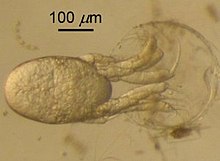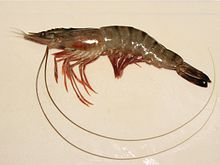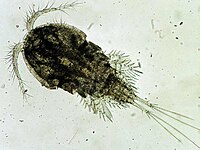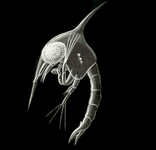Crustacean larva
Crustaceansmay pass through a number of larval and immature stages between hatching from their eggs and reaching their adult form. Each of the stages is separated by amoult,in which the hardexoskeletonis shed to allow the animal to grow. Thelarvaeofcrustaceansoften bear little resemblance to the adult, and there are still cases where it is not known what larvae will grow into what adults. This is especially true of crustaceans which live as benthic adults (on the sea bed), more-so than where the larvae areplanktonic,and thereby easily caught.
Many crustacean larvae were not immediately recognised as larvae when they were discovered, and were described as new genera and species. The names of these genera have become generalised to cover specific larval stages across wide groups of crustaceans, such aszoeaandnauplius.Other terms described forms which are only found in particular groups, such as theglaucothoeofhermit crabs,or thephyllosomaofslipper lobstersandspiny lobsters.
Life cycle[edit]
At its most complete, a crustacean's life cycle begins with anegg,which is usuallyfertilised,but may instead be produced byparthenogenesis.This egg hatches into a pre-larva or pre-zoea. Through a series of moults, the young animal then passes through various zoea stages, followed by a megalopa or post-larva. This is followed bymetamorphosisinto an immature form, which broadly resembles the adult, and after further moults, the adult form is finally reached. Some crustaceans continue to moult as adults, while for others, the development ofgonadssignals the final moult.
Any organs which are absent from the adults do not generally appear in the larvae, although there are a few exceptions, such as thevestigeof the fourthpereiopodin the larvae ofLucifer,and somepleopodsin certainAnomuraandcrabs.[1]In a more extreme example, theSacculinaand otherRhizocephalahave a distinctive nauplius larva with its complex body structure, but the adult form lacks many organs due to extreme adaptation to its parasitic life style.
History of the study of crustacean larva[edit]
Antonie van Leeuwenhoekwas the first person to observe the difference between larval crustaceans and the adults when he watched the eggs ofCyclopshatching in 1699.[1]Despite this, and other observations over the following decades, there was controversy among scientists about whether or notmetamorphosisoccurred in crustaceans, with conflicting observations presented, based on different species, some of which went through a metamorphosis, and some of which did not. In 1828John Vaughan Thompsonpublished a paper "On the Metamorphoses of the Crustacea, and on Zoea, exposing their singular structure and demonstrating they are not, as has been supposed, a peculiar Genus but the Larva of Crustacea!!" However his work was not believed due to crayfish not undergoing metamorphosis.[2]This controversy persisted until the 1840s, and the first descriptions of a complete series of larval forms were not published until the 1870s (Sidney Irving Smithon theAmerican lobsterin 1873;Georg Ossian Sarson theEuropean lobsterin 1875, andWalter Faxonon the shrimpPalaemonetes vulgarisin 1879).[1]
Larval stages[edit]
Nauplius[edit]
The genus nameNaupliuswas published posthumously byOtto Friedrich Müllerin 1785 for animals now known to be the larvae ofcopepods.The nauplius stage (plural:nauplii) is characterised by consisting of only three head segments, which are covered by a singlecarapace.The posterior body, when present, is unsegmented. Each head segment has a pair ofappendages;theantennules, antennae,andmandibles.This larval stage has various lifestyles; some are benthic while others are swimmers, some are feeding while others are non-feeders (lecithotrophic). The nauplius is also the stage at which a simple, unpaired eye is present. The eye is known for that reason as the "naupliar eye", and is often absent in later developmental stages, although it is retained into the adult form in some groups, such as theNotostraca.[3][4]Some crustacean groups lack this larval type,isopodsbeing one example.[5]
Zoea[edit]
The genusZoeawas initially described byLouis Augustin Guillaume Boscin 1802 for an animal now known to be the larva of acrab.[1]The zoea stage (plural:zoeasorzoeae), only found in members ofMalacostraca,[5]is characterised by the use of thethoracicappendages for swimming and a large dorsal spine.[5]
Post-larva[edit]
The post-larva orMegalopae,also found exclusively in the Malacostraca,[5]is characterised by the use of abdominal appendages (pleopods) for propulsion. The post-larva is usually similar to the adult form, and many names have been erected for this stage in different groups.William Elford Leacherected the genusMegalopain 1813 for a post-larval crab; acopepodpost-larva is called acopepodite;abarnaclepost-larva is called acypris;ashrimppost-larva is called aparva;ahermit crabpost-larva is called aglaucothoe;aspiny lobster/furry lobsterspost-larva is called apuerulusand aslipper lobsterpost-larva is called anisto.
Larvae of crustacean groups[edit]
Branchiopoda[edit]
In theBranchiopoda,the offspring hatch as a nauplius or metanauplius larva.[6]
Cephalocarida[edit]
In theMediterraneanhorseshoe shrimpLightiella magdalenina,the young experience 15 stages following the nauplius, termedmetanaupliarstages, and two juvenile stages, with each of the first six stages adding two trunk segments, and the last four segments being added singly.[7]
Remipedia[edit]
The larvae ofremipedesarelecithotrophic,consumingegg yolkrather than using external food sources. This characteristic, which is shared withmalacostracan groupssuch as theDecapodaandEuphausiacea(krill) has been used to suggest a link between Remipedia and Malacostraca.[8]
Malacostraca[edit]
Amphipod hatchlings resemble the adults.[9]
Youngisopodcrustaceans hatch directly into amancastage, which is similar in appearance to the adult. The lack of a free-swimming larval form has led to high rates ofendemismin isopods, but has also allowed them to colonise the land, in the form of thewoodlice.
Stomatopoda[edit]
The larvae of many groups ofmantis shrimpare poorly known. In the superfamilyLysiosquilloidea,the larvae hatch asantizoealarvae, with five pairs of thoracic appendages, and develop intoerichthuslarvae, where the pleopods appear. In theSquilloidea,apseudozoealarva develops into analimalarva, while inGonodactyloidea,apseudozoeadevelops into anerichthus.[10]
A singlefossilstomatopod larva has been discovered, in theUpper JurassicSolnhofenlithographic limestone.[11]

Krill[edit]
The life cycle of krill is relatively well understood, although there are minor variations in detail from species to species. After hatching, the larvae go through several stages callednauplius,pseudometanauplius,metanauplius,calyptopsisandfurciliastages, each of which is sub-divided into several sub-stages. Thepseudometanaupliusstage is exclusive to the so-called "sac-spawners". Until themetanaupliusstage, the larvae are reliant on theyolkreserves, but from thecalyptopsisstage, they begin to feed onphytoplankton.During thefurciliastages, segments with pairs of swimmerets are added, beginning at the frontmost segments, with each new pair only becoming functional at the next moult. After the final furcilia stage, the krill resembles the adult.

Decapoda[edit]

Apart from the prawns of the suborderDendrobranchiata,all decapod crustaceans brood their eggs on the female's pleopods. This has resulted in development in decapod crustaceans being generally abbreviated.[1]There are at most nine larval stages in decapods, as inkrill,and both decapod nauplii and krill nauplii often lackmouthpartsand survive on nutrients supplied in theegg yolk(lecithotrophy). In species with normal development, eggs are roughly 1% of the size of the adult; in species with abbreviated development, and therefore more yolk in the eggs, the eggs may reach 1/9 of the adult's size.[1]
The post-larva ofshrimpis calledparva,after the speciesAcanthephyra parvadescribed byHenri Coutière,but which was later recognised as the larva ofAcanthephyra purpurea.[12]
In the marinelobsters,there are three larval stages, all similar in appearance.
Freshwatercrayfishembryosdiffer from those of other crustaceans in having 40ectoteloblastcells, rather than around 19.[13]The larvae show abbreviated development, and hatch with a full complement of adult appendages with the exceptions of theuropodsand the first pair ofpleopods.[1]

The larvae of theAchelata(slipper lobsters,spiny lobstersandfurry lobsters) are unlike any other crustacean larvae. The larvae are known asphyllosoma,after the genusPhyllosomaerected byWilliam Elford Leachin 1817. They are flattened and transparent, with long legs and eyes on long eyestalks. After passing through 8–10 phyllosoma stages, the larva undergoes "the most profound transformation at a single moult in the Decapoda", when it develops into the so-calledpuerulusstage, which is an immature form resembling the adult animal.[1]
The members of the traditional infraorderThalassinideacan be divided into two groups on the basis of their larvae. According toRobert Gurney,[1]the "homarine group" comprises the familiesAxiidaeandCallianassidae,while the "anomuran group" comprises the familiesLaomediidaeandUpogebiidae.This split corresponds with the division later confirmed withmolecular phylogenetics.[14]
Among theAnomura,there is considerable variation in the number of larval stages. In theSouth AmericanfreshwatergenusAegla,the young hatch from the eggs in the adult form.[1]Squat lobsterspass through four, or occasionally five, larval states, which have a longrostrum,and a spine on either side of thecarapace;the first post-larva closely resembles the adult.[1]Porcelain crabshave two or three larval stages, in which the rostrum and the posterior spine on the carapace are "enormously long".[1]Hermit crabspass through around four larval stages. The post-larva is known as theglaucothoe,after a genus named byHenri Milne-Edwardsin 1830.[1]The glaucothoe is 3 millimetres (0.12 in) long inPagurus longicarpus,but glaucothoe larvae up to 20 mm (0.79 in) are known, and were once thought to represent animals which had failed to develop correctly.[1]Like the preceding stages, the glaucothoe is symmetrical, and although the glaucothoe begins as a free-swimming form, it often acquires agastropod shellto live in; thecoconut crab,Birgus latro,always carries a shell when the immature animal comes ashore, but this is discarded later.[1]
Although they are classified ascrabs,the larvae ofDromiaceaare similar to those of the Anomura, which led many scientists to place dromiacean crabs in the Anomura, rather than with the other crabs. Apart from the Dromiacea, all crabs share a similar and distinctive larval form. The crab zoea has a slender, curvedabdomenand a forkedtelson,but its most striking features are the long rostral and dorsal spines, sometimes augmented by further, lateral spines.[1]These spines can be many times longer than the body of the larva. Crab prezoea larvae have been foundfossilisedin thestomachcontents of theEarly Cretaceousbony fishTharrhias.[15]
Copepoda[edit]
Copepodshave six naupliar stages, followed by a stage called thecopepodid,which has the same number of body segments and appendages in all copepods. The copepodid larva has two pairs of unsegmented swimming appendages, and an unsegmented "hind-body" comprising the thorax and the abdomen.[1]There are typically five copepodid stages, but parasitic copepods may stop after a single copepodid stage. Once the gonads develop, there are no further moults.[1]
Parasitic copepods[edit]

A, leg 3;
B, leg 3 (other specimen);
C, leg 4;
D, caudal ramus;
E, habitus of putative female, dorsal.
Scale bars: A–D = 0.025 mm; E = 0.2 mm.[16]
Chalimus(plural chalimi) is a stage of development of a copepod parasite of fish, such as thesalmon louse(Lepeophtheirus salmonis).[17][18]
ChalimusBurmeister, 1834 is also a synonym forLepeophtheirusNordmann, 1832.
Facetotecta[edit]
The single genus in theFacetotecta,Hansenocaris,is only known from its larvae. They were first described byChristian Andreas Victor Hensenin 1887, and named "y-nauplia" byHans Jacob Hansen,assuming them to be the larvae ofbarnacles.[19]The adults are presumed to beparasitesof other animals.[20]
See also[edit]
References[edit]
- ^abcdefghijklmnopqrRobert Gurney(1942).Larvae of decapod crustacea(PDF).London:Ray Society.pp. 1–306.
- ^Nicolson, Adam (2021). "Crab".Life Between the Tides(1 ed.). New York: Farrar, Straus and Giroux. pp. 116–118.ISBN9780374251437.
- ^Crustaceamorpha: Metamorphosis and Larvae - UCMP Berkeley
- ^Key for the identification of crustacean nauplii - Academia.edu
- ^abcd"Crustaceamorpha: Metamorphosis and Larvae".ucmp.berkeley.edu.UC Museum of Paleontology (UCMP).Retrieved22 August2022.
- ^Branchiopoda (Anostraca, Notostraca, Laevicaudata, Spinicaudata, Cyclestherida)
- ^Alberto Addis; Francesca Biagi; Antonello Floris; Emiliana Puddu; Marcella Carcupino (2007). "Larval development of Lightiella magdalenina (Crustacea, Cephalocarida)".Marine Biology.152(3): 733–744.doi:10.1007/s00227-007-0735-8.S2CID85246439.
- ^Stefan Koenemann; Jørgen Olesen; Frederike Alwes; Thomas Iliffe; Mario Hoenemann; Petra Ungerer; Carsten Wolff; Gerhard Scholtz (2009). "The post-embryonic development of Remipedia (Crustacea)—additional results and new insights".Development Genes and Evolution.219(3): 131–145.doi:10.1007/s00427-009-0273-0.PMID19184096.S2CID11575617.
- ^"The Biology of Amphipods".Museum Victoria.Archived fromthe originalon September 18, 2010.RetrievedJune 7,2010.
- ^S. T. Ahyong; J. K. Lowry."Stomatopoda: Families".World Crustacea.Australian Museum.Archived fromthe originalon December 14, 2010.RetrievedJune 6,2010.
- ^Joachim T. Haug; Carolin Haug; Manfred Ehrlich (2008)."First fossil stomatopod larva (Arthropoda: Crustacea) and a new way of documenting Solnhofen fossils (Upper Jurassic, Southern Germany)"(PDF).Palaeodiversity.1:103–109.
- ^Kemp, Stanley W. (1907)."XI. Biscayan Plankton. Part XI.-Decapoda".Transactions of the Linnean Society of London. 2nd Series: Zoology.10(8): 205–217.doi:10.1111/j.1096-3642.1907.tb00072.x.
- ^G. Scholtz; S. Richter (1995). "Phylogenetic systematics of the reptantian Decapoda (Crustacea, Malacostraca)".Zoological Journal of the Linnean Society.113(3): 289–328.doi:10.1006/zjls.1995.0011.
- ^Sammy De Grave; N. Dean Pentcheff; Shane T. Ahyong; et al. (2009)."A classification of living and fossil genera of decapod crustaceans"(PDF).Raffles Bulletin of Zoology.Suppl. 21: 1–109. Archived fromthe original(PDF)on 2011-06-06.
- ^John G. Maisey & Maria da Gloria P. de Carvalho (1995)."First records of fossil sergestid decapods and fossil brachyuran crab larvae (Arthropoda, Crustacea), with remarks on some supposed palaemonid fossils, from the Santana Formation (Aptian-Albian, NE Brazil)"(PDF).American Museum Novitates(3132): 1–20.
- ^Venmathi Maran, Balu Alagar; Moon, Seong Yong; Ohtsuka, Susumu; Oh, Sung-Yong; Soh, Ho Young; Myoung, Jung-Goo; Iglikowska, Anna; Boxshall, Geoffrey Allan (2013)."The caligid life cycle: new evidence fromLepeophtheirus elegansreconciles the cycles ofCaligusandLepeophtheirus(Copepoda: Caligidae) ".Parasite.20:15.doi:10.1051/parasite/2013015.PMC3718518.PMID23647664.

- ^The salmon louse Lepeophtheirus salmonis (Copepoda: Caligidae) life cycle has only two chalimus stages. LA Hamre, C Eichner, CMA Caipang, ST Dalvin…, PLOS One, 2013
- ^Ultrastructure of the frontal filament in chalimus larvae ofCaligus elongatusand Lepeophtheirus salmonis from Atlantic salmon, Salmo salar. AW Pike, K Mackenzie, A Rowand, Pathogens of wild and farmed fish: sea lice, 1993
- ^E. A. Ponomarenko (2006). "Facetotecta – unsolved riddle of marine biology".Russian Journal of Marine Biology.32(Suppl. 1): S1–S10.doi:10.1134/S1063074006070017.S2CID2943845.
- ^Gerhard Scholtz (2008)."Zoological detective stories: the case of the facetotectan crustacean life cycle".Journal of Biology.7(5): 16.doi:10.1186/jbiol77.PMC2447532.PMID18598383.









